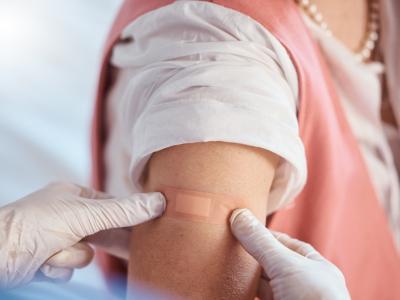Our weekly wrap-up of antimicrobial stewardship & antimicrobial resistance scans
Antibiotic messaging survey finds empowerment more effective than fear
Originally published by CIDRAP News Apr 23
Public campaigns that use "fear-based" messaging to reduce antibiotic use and antimicrobial resistance (AMR) may be more effective if they also contain messages that empower patients to self-manage without antibiotics, UK researchers reported in a study published today in BMC Medicine.
To test the efficacy of fear-based messages, both with and without empowering messages regarding influenza-like illness (ILI) symptoms being easily self-managed without antibiotics, researchers from the National Institute for Health Research Health Protection Research Unit sent a survey to 4,000 UK respondents.
The respondents were randomized to receive three different messages about antibiotic use and AMR: one contained a "fear-only" message, and the other two were "mild-fear-plus-empowerment" and "strong-fear-plus-empowerment". The main outcomes measured were whether the messages were "very/somewhat new" to respondents and whether the messages had an effect on the likelihood of visiting a doctor and requesting antibiotics for ILI.
Overall, 25.2% of respondents said the message they received was "very/somewhat new," with small but significant variation between messages. Of those for whom the respective information was "very/somewhat new," only those given the "strong-fear-plus-empowerment" message were significantly less likely to request antibiotics if they visited a doctor for an ILI (182/388, 46.9%), versus 116/336 (34.5%) of those who received the "mild-fear-plus-empowerment" message and 85/285 (29.8%) who received the "fear-alone" message.
Those for whom the respective information was not "very/somewhat new" said they would be less likely to request antibiotics for ILI across all messages. The three messages had analogous self-reported effects on likelihood of visiting a doctor and in subgroups defined by believing antibiotics would "definitely/probably" help an ILI.
"Consistent with meta-analyses on the effectiveness of fear-based messages in other healthcare areas, the evidence from this study suggests that fear-based messages about antibiotics and AMR are more likely to be effective in reducing consultations and antibiotic requests, especially among those with low AMR awareness, if they include 'empowering' information about effective self-management without antibiotics," the authors conclude.
Apr 23 BMC Med study
Flu vaccination helped reduce antibiotic prescriptions, study finds
Originally published by CIDRAP News Apr 23
A study led by researchers from the US Centers for Disease Control and Prevention has found that influenza vaccination averted 1 in 25 antibiotic prescriptions among outpatients with acute respiratory illness (ARI). The results appeared today in Clinical Infectious Diseases.
For the study, researchers enrolled outpatients 6 months or older who had ARI and were treated at 50 to 60 healthcare facilities that belong to the US Flu Vaccine Effectiveness (VE) Network from 2013 through 2018.
To examine the evidence for the role of influenza vaccination on antibiotic prescribing among these outpatients, they collected data on antibiotic prescribing and diagnosis codes for ARI syndromes and calculated VE by comparing vaccination odds among influenza-positive test cases to test-negative controls. They estimated the number of ARI visits and antibiotic prescriptions averted by influenza vaccination using estimates of VE, coverage, and prevalence of antibiotic prescriptions and influenza.
Over the 5-year study period, among 37,487 enrolled patients, 18,807 (50%) were vaccinated against influenza, and 9,659 (26%) were considered influenza-positive. Antibiotics were prescribed to 36% of patients with ARI and 26% of influenza-positive patients. The top three most prevalent ARI syndromes were viral upper respiratory tract infection (47%), pharyngitis (18%), and allergy or asthma (11%). After adjusting for potential confounders, the overall VE against lab-confirmed influenza was 35% (95% confidence interval [CI], 32% to 39%).
Based on the VE and vaccination coverage, the researchers estimate that vaccination prevented 5.6% of all ARI syndromes, with a range of 2.8% (sinusitis) to 11% (clinical influenza) for each of the clinical syndromes, and 3.8% (95% CI, 3.6% to 4.1%) of antibiotic prescriptions among ARI outpatients.
The authors of the study say the findings are consistent with previous research that suggests antibiotics are overprescribed for ARI syndromes for which they are not indicated. They conclude that improvements in vaccine coverage and effectiveness, combined with efforts to reduce antibiotic use and improve diagnosis and recognition of influenza, are important strategies for reducing antibiotic prescribing for these syndromes.
Apr 23 Clin Infect Dis abstract
Review highlights areas for improvement in UK AMR strategy
Originally published by CIDRAP News Apr 23
A review of the UK government's first 5-year AMR strategy by the Policy Innovation and Evaluation Research Unit (PIRU) at the London School of Hygiene and Tropical Medicine has identified several areas for improvement in both human and animal health that could help strengthen implementation of future AMR policy.
The first UK AMR 5-year strategy, launched in 2013, aimed to slow the development and spread of AMR through improved antibiotic prescribing and infection prevention measures in human and animal health. The PIRU evaluation explored how the strategy was implemented and how AMR is being managed in local health services across the UK in the pig and poultry industries and companion animals.
Among the findings of the review is that while there has been considerable progress in the collection and sharing of AMR data in human health settings, there was a lack of awareness among some local National Health Service (NHS) staff of all the data that are available. In addition, some hospitals have found it easier to meet some AMR control targets than others, and there have been problems introducing and using diagnostic tests designed to distinguish between bacterial and viral infections.
On the animal health side, the review found that livestock sectors were in different stages of improving the way they use antibiotics and collect data, with some private industry groups and professional organizations demonstrating leadership. But more data over a longer period are needed to assess efforts to reduce antibiotic use in animals, and more could be done to harmonize data on AMR and antibiotic use across the human and animal health sectors so that they can be compared more easily. Veterinarians also noted that talking with pet owners about antibiotic use is challenging due to short consultations.
Finally, the review found that patients and members of the public haven’t been involved enough in the development and implementation of the strategy and that increased public involvement could lead to better ways of managing AMR.
Apr 22 PIRU UK AMR strategy evaluation
Study: Hygiene in homes, daily life may reduce antimicrobial resistance
Originally published by CIDRAP News Apr 20
Improved hygiene in homes and communities can reduce AMR by preventing infections and decreasing antibiotic prescribing, according to a position paper commissioned by the Global Hygiene Council in the American Journal of Infection Control.
The authors said that such hygiene measures, combined with provision of clean water and proper sanitation, could reduce the circulation of resistant bacteria, regardless of a country's socioeconomic status.
AMR action plans typically address infection prevention and control only in healthcare settings, but the authors say that the greatest risk of disease transmission occurs in settings such as homes, workplaces, schools, daycares, and on public transportation. This is particularly important in light of increasing numbers of immunocompromised people receiving care at home.
The authors recommend "targeted hygiene" measures such as hand washing and surface disinfection before, during, and after high-risk activities such as food handling, using the toilet, changing diapers, coughing, sneezing, washing clothing, and caring for an infected family member.
To prevent microbicide-related AMR, however, the use of disinfectants needs to be appropriate, with attention to recommended concentrations and contact times.
"The authors call upon national and international policy makers, health agencies and healthcare professionals to further recognize the importance of targeted hygiene in the home and everyday life settings for preventing and controlling infection, in a unified quest to tackle AMR," the authors wrote.
In a related study in the same journal, researchers also highlight the importance of hand washing, but in the setting of reducing hospital-acquired Clostridioides difficile transmissions.
About 2,000 people die of infections with resistant bacteria every day worldwide, or about 730,000 a year, the authors of the position paper wrote.
Apr 17 Am J Infect Control paper and related study
Study supports antibiotics after umbilical clamping in C-sections
Originally published by CIDRAP News Apr 20
A large prospective study by researchers in Switzerland suggests that it is safe to give prophylactic antibiotics to mothers after umbilical cord clamping in Caesarian section, as opposed to before. The results of the study appear in an abstract published by the European Congress of Clinical Microbiology and Infectious Diseases (ECCMID).
The study looked at data on mothers who were given surgical antibiotic prophylaxis (SAP) either within 60 minutes before incision or after clamping at 178 hospitals from 2009 to 2018. Antibiotics included cefuroxime, cefazolin, amoxicillin/clavulanate, or ceftriaxone. Using generalized linear multilevel models that adjusted for patient characteristics, procedural variables, and healthcare system factors, the researchers assessed the association between SAP administration relative to incision and clamping and the surgical site infection (SSI) rate.
Among the 55,901 patients who met the study criteria, SAP was administered before incision in 26,405 patients (47.2%) and after clamping in 29,496 patients (52.8%). Overall, 846 SSIs were documented, of which 379 occurred before incision and 449 after clamping. The adjusted odds ratio (OR) for SAP administration after clamping was not significantly associated with an increased SSI rate (OR, 1.14; 95% CI, 0.96 to 1.36; P = 0.144) when compared to before incision. Supplementary and subgroup analyses supported these main results.
The World Health Organization currently recommends SAP in Caesarian section before incision to reduce the risk of SSIs, but the authors of the study say these findings, and the latest research on the potentially detrimental effects of early-life antibiotic exposure, are reasons to re-evaluate that guidance.
ECCMID was cancelled this year because of the COVID-19 pandemic, but studies scheduled to be presented have been published in a book of abstracts.
Apr 17 ECCMID abstract











